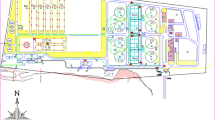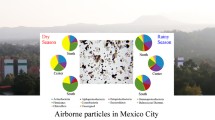Abstract
The search for the chemical and biomarkers of aerosol originating from the surface microlayer (SML) of water areas of health resort zones at Lake Baikal was performed. The concentrations of Ca, Mg, Na, K, Cu, Zn, Fe, Mn, Al, Ba, Pb, Cd, As, naphthalene, acenaphthene, acenaphthilene, fluorene, phenanthrene, anthracene, fluoranthene, pyrene, benz(a)anthracene, perilene, benz (b) fluoranthene, benz(a) pyrene,1,2,5,6-dibenz anthracene, benz(ghi) perilene, and total protein in aerosols and water samples collected from the region were experimentally studied. A direct close interrelation was revealed between the concentrations of all chemical elements in aerosol and water samples. The highest concentrations were recorded for Ca, Mg, Na, and K. A polymerase chain reaction method was employed to determine the similar interrelation between the genetic materials of microorganisms (bacterioplankton) found in water and aerosol. A completely adequate marker reflecting the presence of aerosol generated by SML of Lake Baikal water was not found.
Similar content being viewed by others
References
M. E. Berlyand, Prognoz i regulirovanie zagryazneniya atmosfery (Gidrometeoizdat, Leningrad, 1985) [in Russian].
K. Uork and S. Uorner, Zagryaznenie vozdukha. Istochniki i kontrol’ (Mir, Moscow, 1980) [in Russian].
Khimiya okruzhayushchei sredy, Ed. by Bokris O.M (Khimiya, Moscow, 1978) [in Russian].
O. A. Alekin, Osnovy geokhimii (Gidrometeoizdat, Leningrad, 1970) [in Russian].
A. A. Beus, L. I. Grabovskaya, and N. V. Tikhonova, Geokhimiya okruzhayushchei sredy (Moscow, 1976) [in Russian].
V. D. Korzh, “Relationship between Salt Concentration on the Ocean Surface and in Sea Atmospheric Moisture,” Dokl. AN SSSR 20(2), 332 (1972).
O. P. Petrenchuk, Eksperimental’nye issledovaniya atmosfernogo aerozolya (Gidrometeoizdat, Leningrad, 1979) [in Russian].
V. K. Donchenko and L. S. Ivlev, Ob identifikatsii aerozolei raznogo proiskhozhdeniya: Mater. 3-i mezhdunar. konf., “Estestvennye i antropogennye aerozoli” (NIIKh SPbGU, St. Petersburg, 2003) [in Russian].
V. E. Zuev, B. D. Belan, D. M. Kabanov, et al., “The AN-30 Aircraft Laboratory “Optik-E” for Environmental Study,” Atmos. Ocean. Opt. 10(2), 1012 (1992).
B. D. Belan, “Airborne Ecological Sounding of the Atmosphere,” Atmos. Ocean. Opt. 6(2), 205 (1999).
B. D. Belan, V. E. Zuev, and M. V. Panchenko, “Main results of airborne sounding of aerosol conducted at the Institute of Atmospheric Optics from 1981 till 1991,” Atmos. Ocean. Opt. 8(1–2), 66 (1981).
Gosudarstvennyi standart RF GOST R 51592—2000 “Voda. Obshchie trebovaniya k otboru prob”, Prinyat i vveden v deistvie postanovleniem Gosstandarta RF ot 21 aprelya 2000 g., No. 117-st.
Rukovodstvo po metodam biologicheskogo analiza morskoi vody i donnykh otlozhenii (vremennoe), Ed. by A.V. Tsyban’ (Gidrometeoizdat, Leningrad, 1980) [in Russian].
W. W. You, R. P. Haugland, D. K. Ryan, and R. P. Haugland, “3-(4-Carboxybenzoyl)Quinoline-2-Carboxaldehyde, a Reagent with Broad Dynamic Range for the Assay of Proteins and Lipoproteins in Solution,” Annal. Biochem 244(2), 277 (1997).
Opredelenie politsiklicheskikh aromaticheskikh uglevodorodov (metod vysokoeffektivnoi zhidkostnoi khromatografii). Rukovodstvo po kontrolyu zagryazneniya atmosfery, (RD 52.04.186-89), Gosudarstvennyi komitet SSSR po gidrometeorologii, Ministerstvo zdravookhraneniya SSSR (Moscow, 1991) [in Russian].
B. Mercier, L. Burlot, and C. Ferec, “Simultaneous Screening for HBV DNA and HCV RNA Genomes in Blood Donations Using a Novel TaqMan PCR Assay,” J. Virol. Methods. 77, 1 (1999).
J. R. Marchesi, T. Sato, A. J. Weightman, et al., “Design and evaluation of useful bacterium-specific PCR primers that amplify genes coding for bacterial 16S rRNA,” Appl. Environ. Microbiol. 64(6), 2333 (1998).
B. Diez, C. Pedros-Alio, and R. Massana, “Study of Genetic Diversity of Eukaryotic Picoplankton in Different Oceanic Regions by Small-Subunit rRNA Gene Cloning and Sequencing,” Appl. Environ. Microbiol. 67(7), 2932 (2001).
S. Kumar, K. Tamura, and M. Nei, “MEGA3: Integrated Software for Molecular Evolutionary Genetics Analysis and Sequence Alignment,” Briefings in Bioinformatics 5, 150 (2004).
S. M. Resenchuk and V. M. Blinov, “Alignment Service: Creation and Processing of Alignments of Sequences of Unlimited Length,” Comput. Appl. Biosci. 11(1), 7 (1995).
Kh. Grin and V. Lein, Aerozoli—pyli, dymy i tumany (Khimiya, Leningrad, 1969) [in Russian].
S. K. Friedlander, Smoke, Dust, Haze. Fundamentals of Aerosol Dynamics, 2nd ed. (Oxford, Oxford University Press, New York, 2000).
D. C. Blanchard and A. H. Woodcock, “Bubble Formation and Modification in the Sea and Its Meteorological Significance,” Tellus. 9, 145 (1957).
D. C. Blanchard and L. Syzdek, “Mechanism for the Water-to-Air Transfer and Concentration of Bacteria,” Science 170(3958), 626 (1970).
MacIntyre F., “The Top Millimeter of the Ocean,” Sci. Amer. 230, 62 (1974).
M. Grammatika and W. B. Zimmermann, “Microhydrodynamics of Flotation Processes in the Sea Surface Layer,” Dyn. Atmos. and Oceans 34(2–4), 327 (2001).
G. B. Deane and M. D. Stokes, “Scale Dependence of Bubble Creation Mechanisms in Breaking Waves,” Nature 418(6900), 839 (2002).
Z. Zhang, L. Liu, C. Liu, and W. Cai, “Studies on the Sea Surface Microlayer. II. The Layer of Sudden Change of Physical and Chemical Properties,” J. Colloid and Interface Sci. 264(1), 148 (2003).
A. Cincinelly, A. M. Stortini, M. Perugini, et al., “Organic Pollutants in Sea-Surface Microlayer and Aerosol in the Coastal Environment of Leghron-(Tyrrhenean Sea),” Mar. Chem. 76(1–2), 77 (2001).
B. Gasparovic, M. Plavsic, B. Cosovic, and A. Saliot, “Organic Matter Characterization in the Sea Surface Microlayers in the Subarctic Norwegian Fiords Region,” Mar. Chem. 105(1–2), 1 (2007).
P. A. Matrai, L. Tranvik, C. Leck, and J. C. Knulst, “Are High Arctic Surface Monolayers a Potential Source of Aerosol Organic Precursors?,” Mar. Chem. 108(1–2), 109 (2008).
M. R. Kuznetsova, C. Lee, and J. Y. Aller, “Characterization of the Proteinaceous Matter in Marine Aerosols,” Mar. Chem. 96(3–4), 359 (2005).
R. A. Horne, Marine Chemistry: The Structure of Water and the Chemistry of the Hydrosphere (John Wiley & Sons, Inc, New York, 1969).
R. Saint-Louis and E. Pelletier, “Sea-to-Air Flux of Contaminants via Bursting. An Experimental Approach for Tributylyn,” Mar. Chem. 84(3–4), 211 (2004).
M. T. Perez, C. Pausz, and G. J. Herndl, “Major Shift in Bacterioplankton Utilization of Enantiomeric Amino Acids between Surface Water and the Ocean’s Interior,” Limnol. and Oceanogr. 48(2), 755 (2003).
J. Y. Aller, M. R. Kuznetsova, C. J. Jahns, and P. F. Kemp, “The Sea Surface Microlayer As a Source of Viral and Bacteria Enrichment in Marine Aerosols,” J. Aerosol Sci. 36(5–6), 801 (2005).
Y. De Souza-Lima and J.-C. Romano, “Ecological Aspects of the Surface Microlayer. I. ATP, ADP, AMP Contents, and Energy Charge Ratios of Microplanktonic Communities,” J. Exp. Mar. Biol. Ecol. 70(2), 107 (1983).
S. J. Pogorzelski and A. D. Kogut, “Structural and Thermodynamic Signatures of Marine Microlayer Surfactant Films,” J. Sea Res. 49(4), 347 (2003).
S. M. Henrichs and P. M. Williams, “Dissolved and Particulate Amino Acids and Carbohydrates in the Sea Surface Microlayer,” Mar. Chem. 17(2), 141 (1985).
P. Artaxo and H.-C. Hansson, “Size Distribution of Biogenic Aerosol Particles from the Amazon Basin,” Atmos. Environ. 29(1), 393 (1995).
P. Artaxo and W. Maenhaut, “Trace Element Concentrations and Distribution of Biogenic Aerosols from the Amazon Basin,” Nucl. Instrum. and Meth. Phys. Res. B 49(1–4), 366 (1990).
P. Artaxo, H. Storms, F. Bruynseels, et al., “Composition and Sources of Aerosols From the Amazon Basin,” J. Geophys. Res. D 93(2), 1605 (1988).
P. Artaxo, W. Maenhaut, H. Storms, and R. Van Grieken, “Aerosol Characteristics and Sources for the Amazon Basin during the Wet Season,” J. Geophys. Res. D 95(10), 16 971 (1990).
V. A. Vetrov and A. I. Kuznetsova, Mikroelementy v prirodnykh sredakh regiona ozera Baikal (Izd-vo SO RAN, NITs OIGGM, Novosibirsk, 1997) [in Russian].
K. K. Falkner, M. Church, and C. I. Measures, et al., “Minor and Trace Element Chemistry of Lake Baikal, Its Tributaries and Surrounding Hot Springs,” Limnol. and Oceanogr. 42(2), 329 (1997).
Aerozoli Sibiri, Ed. by K.P. Kutsenogii (Izd-vo SO RAN, Novosibirsk, 2006), p. 95 [in Russian].
A. I. Borodulin, A. S. Safatov, A. N. Shabanov, et al., “Physical Characteristics of Concentration Fields of Tropospheric Bioaerosols in the South of Western Siberia,” J. Aerosol Sci. 36(5–6), 785 (2005).
A. S. Safatov, I. S. Andreeva, G. A. Buryak, et al., “The Results of 7-Year Monitoring of the Biogenic Components of Atmospheric Aerosol in Southwestern Siberia,” Chem. Eng. Transactions 10, 401 (2006).
N. L. Bel’kova, Extended Abstract of Candidate’s Dissertation in Biology (Vladivostok, 2004).
M. Wu, L. Song, J. Ren, and J. Kan, “Pei-Yuan Qian Assessment of Microbial Dynamics in the Pearl River Estuary by 16S rRNA Terminal Restriction Fragment Analysis,” Continental Shelf Research 24(16), 1925 (2004).
M. S. Rappe, K. Vergin, and S. J. Giovannoni, “Phylogenetic Comparisons of a Coastal Bacterioplankton Community with its Counterparts in Open Ocean and Freshwater Systems,” FEMS Microbiol. Ecol. 33(3), 219 (2000).
H. Agogue, E. O. Casamayor, M. Bourrain, et al., “A Survey on Bacteria Inhabiting Sea Surface Microlayer of Coastal Ecosystems,” FEMS Microbiol. Ecol. 54(2), 269 (2005).
X. Peng, K. Fanxiang, C. Huansheng, and Z. Min, “Relationship between Bacterioplankton and Phytoplankton Community Dynamics during Late Spring and Early Summer in Lake Taihu, China,” Acta Ecol. Sin. 27(5), 1696 (2007).
P. F. Kemp and J. Y. Aller, “Bacterial Diversity in Aquatic and Other Environments: What 16S rDNA Libraries Can Tell Us,” FEMS Microbiol. Ecol. 47(2), 161 (2004).
M. G. Weinbauer, “Ecology of Prokaryotic Viruses,” FEMS Microbiol. Rev. 28(2), 127 (2004).
S. G. Wakeham, R. Amann, K. H. Freeman, et al., “Microbial Ecology of the Stratified Water Column of the Black Sea As Revealed by a Comprehensive Biomarker Study,” Organic Geochem. 38(12), 2070 (2007).
Wurl O. and Obbard J.P., “A Review of Pollutants in the Sea-Surface Microlayer (SML): A Unique Habitat for Marine Organisms,” Marine Pollution Bul. 48(11–12), 1016 (2004).
Author information
Authors and Affiliations
Additional information
Original Russian Text © A.N. Sergeev, A.S. Safatov, A.P. Agafonov, I.S. Andreeva, M.Yu. Arshinov, B.D. Belan, G.A. Buryak, V.M. Generalov, Yu.R. Zakharova, N.A. Lapteva, S.E. Ol’kin, M.V. Panchenko, V.V. Parfenova, I.K. Reznikova, D.V. Simonenkov, T.V. Teplyakova, V.A. Ternovoi, 2009, published in Optica Atmosfery i Okeana.
Rights and permissions
About this article
Cite this article
Sergeev, A.N., Safatov, A.S., Agafonov, A.P. et al. Comparison of the presence of chemical and biomarkers in the surface microlayer in water areas of health resort zones of Lake Baikal and in atmospheric aerosol of this region. Atmos Ocean Opt 22, 467–477 (2009). https://doi.org/10.1134/S1024856009040137
Received:
Published:
Issue Date:
DOI: https://doi.org/10.1134/S1024856009040137




